and an English nurse during the
the “cult of experience,” Heming-
war; For Whom the Bell Tolls (1940),
way often involved his characters in
set during the Spanish Civil War;
dangerous situations in order to
and The Old Man and the Sea.
reveal their inner natures; in his
later works, the danger sometimes
William Faulkner (1897-1962)
becomes an occasion for mascu-
Born to an old southern family,
line assertion.
William Harrison Faulkner was
Photo © UPI/The Bettmann
Like Fitzgerald, Hemingway be-
Archive
raised in Oxford, Mississippi,
71
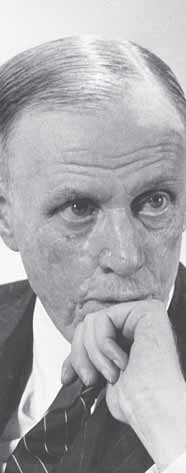
where he lived most of his life.
as much as in the subject at hand.
Faulkner created an entire imagi-
The use of various viewpoints
native landscape, Yoknapatawpha
makes Faulkner more self-referen-
County, mentioned in numerous
tial, or “reflexive,” than Hemingway
novels, along with several families
or Fitzgerald; each novel reflects
with interconnections extending
upon itself, while it simultaneously
back for generations. Yoknapat-
unfolds a story of universal inter-
awpha County, with its capital,
est. Faulkner’s themes are south-
“Jefferson,” is closely modeled on
ern tradition, family, community, the
Oxford, Mississippi, and its sur-
land, history and the past, race, and
roundings. Faulkner re-creates the
the passions of ambition and love.
history of the land and the various
He also created three novels focus-
races — Indian, African-American,
ing on the rise of a degenerate fam-
Euro-American, and various mix-
ily, the Snopes clan: The Hamlet
tures — who have lived on it. An
(1940), The Town (1957), and The
innovative writer, Faulkner experi-
Mansion (1959).
mented brilliantly with narrative
chronology, different points of view
NOVELS OF SOCIAL
and voices (including those of out-
AWARENESS
casts, children, and illiterates), and
ince the 1890s, an undercur-
a rich and demanding baroque style
rent of social protest had
S
built of extremely long sentences
coursed through American
full of complicated subordinate
literature, welling up in the nat-
parts.
uralism of Stephen Crane and
The best of Faulkner’s novels
Theodore Dreiser and in the clear
include The Sound and the Fury
messages of the muckraking novel-
(1929) and As I Lay Dying (1930),
ists. Later socially engaged authors
two modernist works experiment-
included Sinclair Lewis, John
ing with viewpoint and voice to
Steinbeck, John Dos Passos,
probe southern families under the
Richard Wright, and the dramatist
stress of losing a family member;
Clifford Odets. They were linked to
Light in August (1932), about com-
SINCLAIR LEWIS
the 1930s in their concern for the
plex and violent relations between
welfare of the common citizen and
a white woman and a black man;
their focus on groups of people —
and Absalom, Absalom! (1936), per-
the professions, as in Sinclair
haps his finest, about the rise of a
Lewis’s archetypal Arrowsmith (a
self-made plantation owner and his
physician) or Babbitt (a local busi-
tragic fall through racial prejudice
nessman); families, as in Stein-
and a failure to love.
beck’s The Grapes of Wrath; or
Most of these novels use differ-
urban masses, as Dos Passos ac-
ent characters to tell parts of the
complishes through his 11 major
story and demonstrate how mean-
characters in his U.S.A. trilogy.
Photo courtesy
ing resides in the manner of telling,
Pix Publishing, Inc.
72

Sinclair Lewis (1885-1951)
stresses that develop within the
Harry Sinclair Lewis was born in
marriage of an older judge and his
Sauk Centre, Minnesota, and grad-
young wife.
uated from Yale University. He took
time off from school to work at a
John Dos Passos (1896-1970)
socialist community, Helicon Home
Like Sinclair Lewis, John Dos
Colony, financed by muckraking
Passos began as a left-wing radical
novelist Upton Sinclair. Lewis’s
but moved to the right as he aged.
Main Street
(1920) satirized
Dos Passos wrote realistically, in
monotonous, hypocritical small-
line with the doctrine of socialist
town life in Gopher Prairie,
realism. His best work achieves a
Minnesota. His incisive presenta-
scientific objectivism and almost
tion of American life and his criti-
documentary effect. Dos Passos
cism of American materialism, nar-
developed an experimental collage
rowness, and hypocrisy brought
technique for his masterwork
him national and international
U.S.A. , consisting of The 42nd
recognition. In 1926, he was
Parallel (1930), 1919 (1932), and
offered and declined a Pulizer
The Big Money (1936). This sprawl-
Prize for Arrowsmith (1925), a
ing collection covers the social his-
novel tracing a doctor’s efforts to
tory of the United States from 1900
maintain his medical ethics amid
to 1930 and exposes the moral cor-
greed and corruption. In 1930, he
ruption of materialistic American
became the first American to win
society through the lives of its
the Nobel Prize for Literature.
characters.
ewis’s other major novels in-
Dos Passos’s new techniques in-
clude Babbitt (1922). George
cluded “newsreel” sections taken
LBabbitt is an ordinary busi-
from contemporary headlines, pop-
nessman living and working in
ular songs, and advertisements, as
Zenith, an ordinary American town.
well as “biographies” briefly set-
Babbitt is moral and enterprising,
ting forth the lives of important
and a believer in business as the
Americans of the period, such as
new scientific approach to modern
JOHN STEINBECK
inventor Thomas Edison, labor
life. Becoming restless, he seeks
organizer Eugene Debs, film star
fulfilment but is disillusioned by an
Rudolph Valentino, financier J.P.
affair with a bohemian woman, re-
Morgan, and sociologist Thorstein
turns to his wife, and accepts his
Veblen. Both the newsreels and
lot. The novel added a new word to
biographies lend Dos Passos’s nov-
the American language — “babbit-
els a documentary value; a third
try,” meaning narrow-minded, com-
technique, the “camera eye,” con-
placent, bourgeois ways. Elmer
sists of stream of consciousness
Gantry (1927) exposes revivalist
prose poems that offer a subjective
religion in the United States, while
response to the events described in
Photo courtesy
Cass Timberlane (1945) studies the
Pinney & Beecher
the books.
73

John Steinbeck (1902-1968)
American jazz swept the United
Like Sinclair Lewis, John
States by storm, and jazz musicians
Steinbeck is held in higher critical
and composers like Duke Ellington
esteem outside the United States
became stars beloved across the
than in it today, largely because he
United States and overseas. Bessie
received the Nobel Prize for
Smith and other blues singers pre-
Literature in 1963 and the interna-
sented frank, sensual, wry lyrics
tional fame it confers. In both
raw with emotion. Black spirituals
cases, the Nobel Committee select-
became widely appreciated as
ed liberal American writers noted
uniquely beautiful religious music.
for their social criticism.
Ethel Waters, the black actress, tri-
Steinbeck, a Californian, set
umphed on the stage, and black
much of his writing in the Salinas
American dance and art flourished
Valley near San Francisco. His best
with music and drama.
known work is the Pulitzer Prize-
Among the rich variety of talent
winning novel The Grapes of Wrath
in Harlem, many visions coexisted.
(1939), which follows the travails of
Carl Van Vechten’s sympathetic
a poor Oklahoma family that loses
1926 novel of Harlem gives some
its farm during the Depression and
idea of the complex and bitter-
travels to California to seek work.
sweet life of black America in the
Family members suffer conditions
face of economic and social
of feudal oppression by rich
inequality.
landowners. Other works set in
The poet Countee Cullen (1903-
California include Tortilla Flat
1946), a native of Harlem who was
(1935), Of Mice and Men (1937),
briefly married to W.E.B. Du Bois’s
Cannery Row (1945), and East of
daughter, wrote accomplished
Eden (1952).
rhymed poetry, in accepted forms,
Steinbeck combines realism with
which was much admired by whites.
a primitivist romanticism that finds
He believed that a poet should not
virtue in poor farmers who live
allow race to dictate the subject
close to the land. His fiction
matter and style of a poem. On the
demonstrates the vulnerability of
other end of the spectrum were
such people, who can be uprooted
African-Americans who rejected
by droughts and are the first to suf-
the United States in favor of
fer in periods of political unrest
Marcus Garvey’s “Back to Africa”
JEAN TOOMER
and economic depression.
movement. Somewhere in between
lies the work of Jean Toomer.
THE HARLEM RENAISSANCE
uring the exuberant 1920s,
Jean Toomer (1894-1967)
Harlem, the black commu-
Like Cullen, African-American
Dnity situated uptown in New
fiction writer and poet Jean
York City, sparkled with passion and
Toomer envisioned an American
Photo © UPI/The Bettmann
creativity. The sounds of its black
Archive
identity that would transcend race.
74
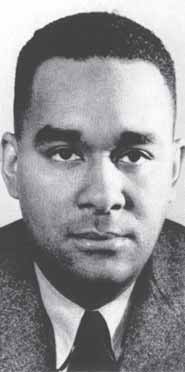
Perhaps for this reason, he bril-
when the boy was five. Wright was
liantly employed poetic traditions
the first African-American novelist
of rhyme and meter and did not
to reach a general audience, even
seek out new “black” forms for his
though he had barely a ninth grade
poetry. His major work, Cane
education. His harsh childhood is
(1923), is ambitious and innovative,
depicted in one of his best books,
however. Like Williams’s Paterson,
his autobiography, Black Boy
Cane incorporates poems, prose
(1945). He later said that his sense
vignettes, stories, and autobio-
of deprivation, due to racism, was
graphical notes. In it, an African-
so great that only reading kept him
American struggles to discover his
alive.
selfhood within and beyond the
The social criticism and realism
black communities in rural Georgia,
of Sherwood Anderson, Theodore
Washington, D.C., and Chicago,
Dreiser, and Sinclair Lewis espe-
Illinois, and as a black teacher in
cially inspired Wright. During the
the South. In Cane, Toomer’s
1930s, he joined the Communist
Georgia rural black folk are natural-
party; in the 1940s, he moved to
ly artistic:
France, where he knew Gertrude
Stein and Jean-Paul Sartre and
Their voices rise...the pine trees
became an anti-Communist. His
are guitars,
outspoken writing blazed a path
Strumming, pine-needles fall
for subsequent African-American
like sheets of rain...
novelists.
Their voices rise...the chorus of
is work includes Uncle Tom’s
the cane
Children (1938), a book of
H
Is caroling a vesper to the
short stories, and the pow-
stars...(I, 21-24)
erful and relentless novel Native
RICHARD WRIGHT
Son (1940), in which Bigger
Cane contrasts the fast pace of
Thomas, an uneducated black
African-American life in the city of
youth, mistakenly kills his white
Washington:
employer’s daughter, gruesomely
burns the body, and murders his
Money burns the pocket, pocket
black girlfriend — fearing she will
hurts,
betray him. Although some African-
Bootleggers in silken shirts,
Americans have criticized Wright
Ballooned, zooming Cadillacs,
for portraying a black character as
Whizzing, whizzing down the
a murderer, Wright’s novel was a
street-car tracks. (II, 1-4)
necessary and overdue expression
of the racial inequality that has
Richard Wright (1908-1960)
been the subject of so much debate
Richard Wright was born into
in the United States.
a poor Mississippi sharecropping
Photo courtesy
family that his father deserted
Howard University
75
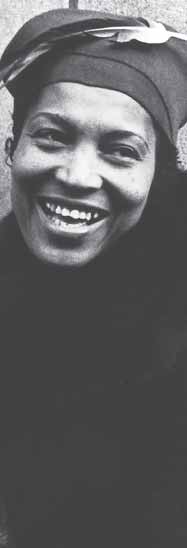
Zora Neale Hurston
binger of the women’s movement,
(1903-1960)
Hurston inspired and influenced
Born in the small town of
such contemporary writers as Alice
Eatonville, Florida, Zora Neale
Walker and Toni Morrison through
Hurston is known as one of the
books such as her autobiography,
lights of the Harlem Renaissance.
Dust Tracks on a Road (1942).
She first came to New York City at
the age of 16 — having arrived as
LITERARY CURRENTS: THE
part of a traveling theatrical troupe.
FUGITIVES
A strikingly gifted storyteller who
AND NEW CRITICISM
captivated her listeners, she at-
rom the Civil War into the
tended Barnard College, where she
20th century, the southern
F
studied with anthropologist Franz
United States had remained a
Boaz and came to grasp ethnicity
political and economic backwater
from a scientific perspective. Boaz
ridden with racism and supersti-
urged her to collect folklore from
tion, but, at the same time, blessed
her native Florida environment,
with rich folkways and a strong
which she did. The distinguished
sense of pride and tradition. It had
folklorist Alan Lomax called her
a somewhat unfair reputation for
Mules and Men (1935) “the most
being a cultural desert of provin-
engaging, genuine, and skillful-
cialism and ignorance.
ly written book in the field of
Ironically, the most significant
folklore.”
20th-century regional literary
Hurston also spent time in Haiti,
movement was that of the Fugitives
studying voodoo and collecting Ca-
— led by poet-critic-theoretician
ribbean folklore that was antholo-
John Crowe Ransom, poet Allen
gized in Tell My Horse (1938). Her
Tate, and novelist-poet-essayist
natural command of colloquial En-
Robert Penn Warren. This southern
glish puts her in the great tradition
literary school rejected “northern”
of Mark Twain. Her writing sparkles
urban, commercial values, which
with colorful language and comic
they felt had taken over America.
— or tragic — stories from the
The Fugitives called for a return to
African-American oral tradition.
the land and to American traditions
Hurston was an impressive nov-
that could be found in the South.
ZORA NEALE HURSTON
elist. Her most important work,
The movement took its name from
Their Eyes Were Watching God
a literary magazine, The Fugitive,
(1937), is a moving, fresh depiction
published from 1922 to 1925 at
of a beautiful mulatto woman’s
Vanderbilt University in Nashville,
maturation and renewed happiness
Tennessee, and with which Ran-
as she moves through three mar-
som, Tate, and Warren were all
riages. The novel vividly evokes the
associated.
lives of African-Americans working
These three major Fugitive writ-
Photo © Carl Van Vechten,
the land in the rural South. A har-
courtesy Yale University
ers were also associated with New
76
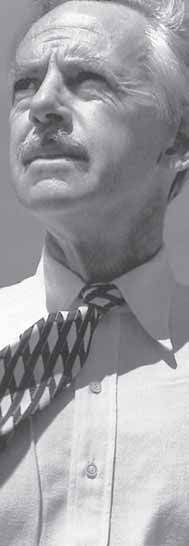
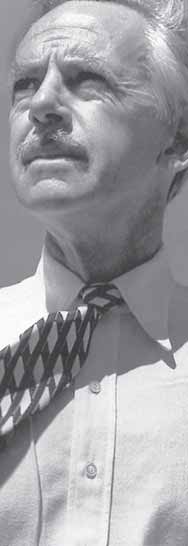
Criticism, an approach to under-
wine, enjoyed higher status than
standing literature through close
indigenous productions.
readings and attentiveness to for-
During the 19th century, melo-
mal patterns (of imagery, meta-
dramas with exemplary democratic
phors, metrics, sounds, and sym-
figures and clear contrasts be-
bols) and their suggested mean-
tween good and evil had been pop-
ings. Ransom, leading theorist of
ular. Plays about social problems
the southern renaissance between
such as slavery also drew large
the wars, published a book, The
audiences; sometimes these plays
New Criticism (1941), on this
were adaptations of novels like
method, which offered an alterna-
Uncle Tom’s Cabin. Not until the
tive to previous extra-literary meth-
20th century would serious plays
ods of criticism based on histo-
attempt aesthetic innovation. Pop-
ry and biography. New Criticism
ular culture showed vital devel-
became the dominant American
opments, however, especially in
critical approach in the 1940s and
vaudeville (popular variety theater
1950s because it proved to be well-
involving skits, clowning, music, and
suited to modernist writers such as
the like). Minstrel shows, based on
Eliot and could absorb Freudian
African-American music and folk-
theory (especially its structural
ways, performed by white charac-
categories such as id, ego, and
ters using “blackface” makeup,
superego) and approaches drawing
also developed original forms and
on mythic patterns.
expressions.
20TH-CENTURY AMERICAN
Eugene O’Neill (1888-1953)
DRAMA
Eugene O’Neill is the great figure
merican drama imitated
of American theater. His numerous
English and European the-
plays combine enormous technical
Aater until well into the 20th
originality with freshness of vision
century. Often, plays from England
and emotional depth. O’Neill’s ear-
or translated from European lan-
liest dramas concern the working
guages dominated theater seasons.
class and poor; later works explore
An inadequate copyright law that
subjective realms, such as obses-
failed to protect and promote
sions and sex, and underscore his
EUGENE O’NEILL
American dramatists worked
reading in Freud and his anguished
against genuinely original drama.
attempt to come to terms with his
So did the “star system,” in which
dead mother, father, and brother.
actors and actresses, rather than
His play Desire Under the Elms
the actual plays, were given most
(1924) recreates the passions hid-
acclaim. Americans flocked to see
den within one family; The Great
European actors who toured the-
God Brown (1926) uncovers the
aters in the United States. In addi-
unconsciousness of a wealthy busi-
tion, imported drama, like imported Photo © The Bettmann Archive nessman; and Strange Interlude 77
(1928), a winner of the Pulitzer Prize, traces the Thornton Wilder (1897-1975)
tangled loves of one woman. These powerful
Thornton Wilder is k










